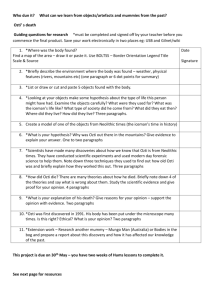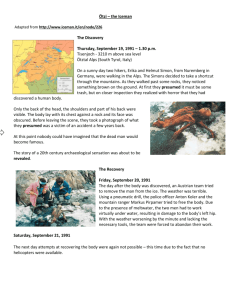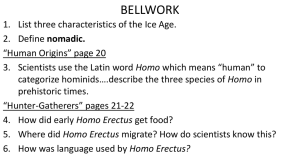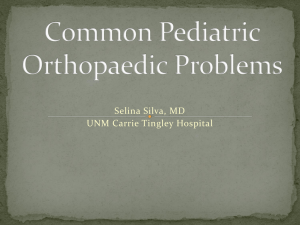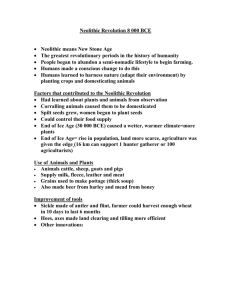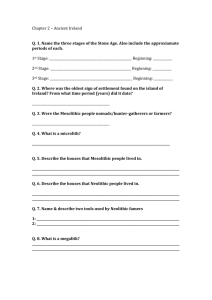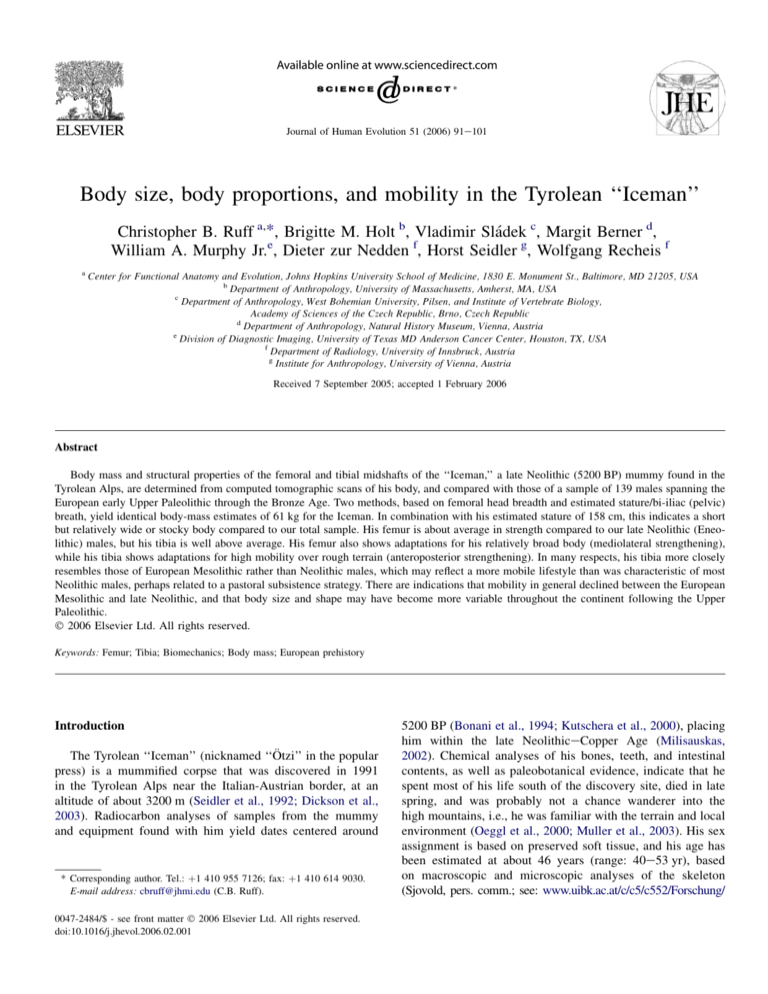
Journal of Human Evolution 51 (2006) 91e101
Body size, body proportions, and mobility in the Tyrolean ‘‘Iceman’’
Christopher B. Ruff a,*, Brigitte M. Holt b, Vladimir Sládek c, Margit Berner d,
William A. Murphy Jr.e, Dieter zur Nedden f, Horst Seidler g, Wolfgang Recheis f
a
Center for Functional Anatomy and Evolution, Johns Hopkins University School of Medicine, 1830 E. Monument St., Baltimore, MD 21205, USA
b
Department of Anthropology, University of Massachusetts, Amherst, MA, USA
c
Department of Anthropology, West Bohemian University, Pilsen, and Institute of Vertebrate Biology,
Academy of Sciences of the Czech Republic, Brno, Czech Republic
d
Department of Anthropology, Natural History Museum, Vienna, Austria
e
Division of Diagnostic Imaging, University of Texas MD Anderson Cancer Center, Houston, TX, USA
f
Department of Radiology, University of Innsbruck, Austria
g
Institute for Anthropology, University of Vienna, Austria
Received 7 September 2005; accepted 1 February 2006
Abstract
Body mass and structural properties of the femoral and tibial midshafts of the ‘‘Iceman,’’ a late Neolithic (5200 BP) mummy found in the
Tyrolean Alps, are determined from computed tomographic scans of his body, and compared with those of a sample of 139 males spanning the
European early Upper Paleolithic through the Bronze Age. Two methods, based on femoral head breadth and estimated stature/bi-iliac (pelvic)
breath, yield identical body-mass estimates of 61 kg for the Iceman. In combination with his estimated stature of 158 cm, this indicates a short
but relatively wide or stocky body compared to our total sample. His femur is about average in strength compared to our late Neolithic (Eneolithic) males, but his tibia is well above average. His femur also shows adaptations for his relatively broad body (mediolateral strengthening),
while his tibia shows adaptations for high mobility over rough terrain (anteroposterior strengthening). In many respects, his tibia more closely
resembles those of European Mesolithic rather than Neolithic males, which may reflect a more mobile lifestyle than was characteristic of most
Neolithic males, perhaps related to a pastoral subsistence strategy. There are indications that mobility in general declined between the European
Mesolithic and late Neolithic, and that body size and shape may have become more variable throughout the continent following the Upper
Paleolithic.
Ó 2006 Elsevier Ltd. All rights reserved.
Keywords: Femur; Tibia; Biomechanics; Body mass; European prehistory
Introduction
The Tyrolean ‘‘Iceman’’ (nicknamed ‘‘Ötzi’’ in the popular
press) is a mummified corpse that was discovered in 1991
in the Tyrolean Alps near the Italian-Austrian border, at an
altitude of about 3200 m (Seidler et al., 1992; Dickson et al.,
2003). Radiocarbon analyses of samples from the mummy
and equipment found with him yield dates centered around
* Corresponding author. Tel.: þ1 410 955 7126; fax: þ1 410 614 9030.
E-mail address: cbruff@jhmi.edu (C.B. Ruff).
0047-2484/$ - see front matter Ó 2006 Elsevier Ltd. All rights reserved.
doi:10.1016/j.jhevol.2006.02.001
5200 BP (Bonani et al., 1994; Kutschera et al., 2000), placing
him within the late NeolithiceCopper Age (Milisauskas,
2002). Chemical analyses of his bones, teeth, and intestinal
contents, as well as paleobotanical evidence, indicate that he
spent most of his life south of the discovery site, died in late
spring, and was probably not a chance wanderer into the
high mountains, i.e., he was familiar with the terrain and local
environment (Oeggl et al., 2000; Muller et al., 2003). His sex
assignment is based on preserved soft tissue, and his age has
been estimated at about 46 years (range: 40e53 yr), based
on macroscopic and microscopic analyses of the skeleton
(Sjovold, pers. comm.; see: www.uibk.ac.at/c/c5/c552/Forschung/
92
C.B. Ruff et al. / Journal of Human Evolution 51 (2006) 91e101
Iceman/agepress-en.html). He is currently housed in a special
climate-controlled chamber in the South Tyrol Museum of
Archaeology in Bolzano, Italy.
Because of his state of preservation, including soft tissue
and the remains of clothing and tools, and chronological age
(the earliest known mummy from Europe), the Iceman has
been one of the most intensively studied prehistoric individuals in the world (for recent reviews, see Dickson et al.,
2003; Muller et al., 2003; Murphy et al., 2003). As part of
those investigations, a series of CT scans of his body were
carried out beginning shortly after his discovery (Murphy
et al., 2003). We report here on information extracted from
one of these examinations that sheds further light on his
body size, proportions, and lower limb-bone structural properties, with implications for reconstructing his activity patterns.
Comparisons are made to a large sample of prehistoric European skeletons, ranging from early Upper Paleolithic through
the Bronze Age. Based on these comparisons, we also offer
some more general observations regarding temporal trends in
body shape and mobility in this region.
Materials and methods
The CT scans used in this investigation were taken in May,
1994, using a spiral CT scanner at the University of Innsbruck
(Somatom Plus 40; Siemens). Images were examined and linear and angular skeletal dimensions were measured using the
software application Osiris 4.0.7. Images were imported into
a version of NIH Image 1.62 with a custom-designed macro
for determination of bone cross-sectional geometric properties
(for a copy of the macro, see: www.hopkinsmedicine.org/fae/
mmacro.htm). Geometric section properties were determined
at two locations: the midshaft of the right femur and the midshaft of the left tibia (with midshaft defined relative to bone
length’, see Ruff, 2002). The right femur was chosen because
it is fixed more nearly parallel to the long axis of the Iceman’s
body (and thus transverse to the plane of the CT images) than
the left femur (for an illustration of the whole body, see Dickson et al., 2003). Although the right tibia is also slightly more
longitudinally oriented than the left tibia, it could not be used
for this analysis because a large piece of the cortex is missing
from the midshaft region. The exact positioning of each bone
in three-dimensional space was determined by comparing x, y
coordinates of articular centers and other bony landmarks and
relating these to standardized positioning protocols (Ruff,
2002). Slight anteroposterior (A-P) and mediolateral (M-L)
angling of the femoral and tibial shafts (< 10 ) was corrected
trigonometrically. In addition, the right femur in the mummy
is twisted 25 about its longitudinal axis and the left tibia
65 about its longitudinal axis, relative to standardized orientations (Ruff, 2002); this was corrected by rotating the sections
within the NIH Image analysis program prior to analysis.
Body mass of the Iceman was calculated using two different but complementary techniques based on: a) estimated stature and bi-iliac (maximum pelvic) breadth and b) femoral
head breadth (Auerbach and Ruff, 2004). For the stature/
bi-iliac technique, a recently revised equation was used
(Ruff et al., 2005). Three equations based on femoral head
breadth are available (Ruff et al., 1991; McHenry, 1992; Grine
et al., 1995); because the Iceman is intermediate in body size
(i.e., not very small or very large relative to most living humans),
an average of all three estimates was used here (for discussion
and justification, see Auerbach and Ruff, 2004). Bi-iliac
breadth and femoral head breadth (of the right femur) were
measured directly from appropriate CT scan slices (see below
for images). Because only A-P breadth of the femoral head can
be measured on a transverse CT slice, and all body-mass estimation formulae are based on S-I (superoinferior) breadth,
A-P breadth was corrected to S-I breadth using a relationship
derived from a diverse modern human sample (Ruff, 2000b):
S-I ¼ 1.004 A-P (SEE ¼ 0.67 mm). Stature was estimated
both from regression formulae based on femoral length and
from direct measurement of the body (Seidler et al., 1992).
Comparative samples are listed in Table 1. All are European
and range from the early Upper Paleolithic (30,000 BP)
through the Bronze Age (3,500 BP), thus bracketing the time
period of the Iceman. The Upper Paleolithic and Mesolithic
samples are derived from sites throughout Europe (Holt,
2003), while the Neolithic and Bronze Age samples are almost
entirely derived from sites in central Europe, specifically lower
Austria, Moravia, and Bohemia (Sládek et al., 2006, in press).
The possible effects of this unequal geographic distribution on
comparisons are discussed below. It should also be noted that
our comparative Neolithic sample is late Copper Age, or Eneolithic, and thus slightly younger than the Iceman. The Mesolithic sample includes some Scandinavian material (Holt,
2003), explaining the relatively late (5,300 BP) upper limit
for this period.
Because the Iceman is male, all of our comparative analyses included only (adult) males. A total of 139 individuals
were included in the study, with most (n ¼ 100) possessing
both an intact femur and tibia (Table 1). Cross-sectional properties of the midshaft femur and tibia were determined through
analysis of section contours obtained from external molds and
biplanar radiographs or CT scans (Holt, 2003; Sládek et al.,
2006, in press).
Body mass for the comparative sample was determined in
the same way as for the Iceman, using a combination of estimations from stature/bi-iliac breadth and femoral head breadth
(Auerbach and Ruff, 2004), as available. Body masses for the
majority of individuals (62% of the males) were estimated using femoral head breadth (with A-P breadths corrected to S-I
Table 1
Comparative samples (males)
Period
Early Upper
Paleolithic
Late Upper
Paleolithic
Mesolithic
Neolithic
Bronze
1
Years BP
Individuals
Femora1
Tibiae1
20,000e30,000
11
11
7
10,000e19,000
14
14
12
5,300e9,000
4,200e4,800
3,500e4,200
32
36
46
30
30
41
26
29
33
Included in cross-sectional geometric analyses.
C.B. Ruff et al. / Journal of Human Evolution 51 (2006) 91e101
breadths as necessary using the formula given above), again
taking the average of the three femoral breadth formulae
results. Bi-iliac breadth could be measured in only 19% of
the males; body-mass estimates from stature/bi-iliac breadth
were averaged with those from the femoral head for these
individuals, except for two individuals for whom femoral
head breadths were not available. In the remainder of the sample (19%), body mass was estimated from stature and estimated bi-iliac breadth, with bi-iliac breadth estimated from
femoral length using a previously described technique employing the average slope between the two variables in recent
humans, keyed to the mean bi-iliac breadth and femoral length
of the appropriate sample (i.e., the five periods shown in Table 1)
(Trinkaus and Ruff, 1999). Estimated bi-iliac breadths were only
used for body-mass calculations and not analyses of body
shape. Statures were estimated from maximum femoral length.
Following from known differences in relative limb length
(Holliday, 1997; Formicola, 2003), Trotter and Gleser’s
(1952) formula for U.S. blacks was used for early Upper
Paleolithic specimens, while Sjovold’s (1990: Table 1,
‘‘Femur 1’’) ‘‘Caucasian’’ formula, based on modern Euroamericans, was used for specimens from subsequent time
periods. Other possible stature estimation equations for the
later time periods, including Trotter and Gleser’s (1952)
U.S. white formula and Formicola and Franceschi’s (1996)
formulae based on a European Neolithic sample, were found
to produce more variance between body-mass estimates
when compared to estimates based on the femoral head. The
Sjovold technique was also used in the original stature estimate for the Iceman, and compared well with direct measurement of his body (Seidler et al., 1992; see below). In a few
cases, body mass could not be determined for an individual
in the comparative sample due to the lack of a femur (or biiliac breadth), but tibial cross-sectional data were still
collected. Conversely, in a few other cases, body mass could
be estimated but cross-sectional data were incomplete.
The LOWESS nonparametric plotting technique (Cleveland, 1979) was used to examine temporal trends within the
comparative sample, using a smoothing window width of
0.5. All statistics and graphics were generated using SYSTAT
(SYSTAT: Statistics, 1990).
93
Results
Body size
Maximum pelvic breadth of the Iceman, measured through
the iliac crests, is 26.4 cm (Figure 1a). Although the sacroiliac
joint space appears to be somewhat reduced due to desiccation
of articular cartilage, the orientation of the two innominates to
each other and to the sacrum appears undistorted and approximately in anatomical position (as also confirmed by examination of photographs of the whole body; see Dickson et al.,
2003). Correcting for the addition of soft tissue (Ruff et al.,
1997) yields an estimated ‘‘living’’ bi-iliac breadth of 27.9 cm.
Stature of the Iceman based on measurements taken directly on his body is 158 cm (Seidler et al., 1992). Maximum
femoral length, measured as the distance between appropriate
CT slices following trigonometric positional correction, is
411 mm. Using this length, Sjovold’s (1990) ‘‘Caucasian’’ formula yields an identical stature estimate of 158 cm; similar results are obtained using Trotter and Gleser’s (1952) U.S. white
male formula (159 cm), and Formicola and Franceschi’s
(1996) European Neolithic male formulae (158 cm and
157 cm for least squares and major axis formulae, respectively). Thus, a stature estimate of 158 cm for the Iceman
seems to be well justified. Based on this stature and a living
bi-iliac breadth of 27.9 cm, body mass of the Iceman is estimated as 61.0 kg, using a formula derived from a worldwide sample of living males (Ruff et al., 2005).
Anteroposterior femoral head breadth of the Iceman is
44.1 mm (Figure 1b), producing an estimated S-I breadth of
44.3 mm (see above). Entering this value into the formulae
of Ruff et al. (1991), McHenry (1992), and Grine et al.
(1995) yields body-mass estimates ranging from 59.3 to
64.0 kg, with an average of 61.07 kg. This value is almost
identical to that obtained from the stature/bi-iliac technique.
Thus, two complementary but independent approaches converge on the same body-mass estimate of 61 kg.
Temporal trends in stature and body mass for the comparative male sample and the Iceman are shown in Figure 2.
There is a relatively sharp decline in both body-size measures
in the comparative sample from the early Upper Paleolithic
Fig. 1. Transverse CT slices through the Iceman (viewed from below). Scale bars ¼ 2 cm. (A) Measurement of bi-iliac breadth (26.4 cm). (B) Measurement of
femoral head breadth (44.1 mm). Light grey regions are remains of desiccated soft tissue. Note (postmortem) dislocation of left femur from acetabulum.
C.B. Ruff et al. / Journal of Human Evolution 51 (2006) 91e101
94
190
90
A
B
80
Period
BRZ
NEO
BRZ
40
NEO
140
MES
50
LUP
150
MES
60
LUP
160
70
EUP
Body Mass (kg)
170
EUP
Stature (cm)
180
Period
Fig. 2. Temporal trends and position of the Iceman (open star) relative to the comparative male sample for stature (A) and body mass (B). LOWESS line fit through
comparative data. Abbreviations are as follows: EUP, early Upper Paleolithic; LUP, late Upper Paleolithic; MES, Mesolithic; NEO, Neolithic; BRZ, Bronze Age
(see Table 1).
through the Mesolithic, as documented for stature or longbone lengths by previous researchers (Frayer, 1980, 1984;
Jacobs, 1985; Formicola and Giannecchini, 1999). In our sample, there is then an increase in both body-size measures in the
Neolithic that is then maintained in the Bronze Age. However,
it is likely that this apparent increase is brought about at least
in part by the nonrandom geographic sampling of our two later
samples (see Discussion). The Iceman is quite small compared
to our Neolithic male sample, particularly in stature (second
smallest in our sample of 30 with statures, fourth smallest in
our sample of 36 with body masses). Relative to the entire
comparative sample he is less of an outlier but is still small:
1.26 standard deviations (SDs) below the overall sample
mean for stature (166.8 7.0 cm, n ¼ 124) and 0.92 SDs
below the mean body mass (67.4 7.0 kg, n ¼ 135).
Femoral and tibial cross-sectional geometry
CT images of the Iceman through the femoral and tibial
midshafts are shown in Figure 3. Images were rotated to maintain a constant orientation relative to standardized reference
axes (Ruff, 2002) and are presented as if the bones were
from the right side, viewed proximodistally. Section properties
and their definitions are given in Table 2.
Relative cortical area, summarized as %CA (CA/TA 100), is high in the Iceman (femur: 85.6%; tibia: 84.9%) compared to our total sample of males (femur: 76.1% 6.2; tibia
78.1% 7.4) or Neolithic males only (femur: 73.9% 5.6;
tibia: 72.9% 5.5). In fact, the relative medullary size and
cortical thickness of his femoral midshaft is similar to that
of early-middle Pleistocene Homo, although within the range
of modern humans (Ruff et al., 1993). Relative cortical thickness, however, is not a direct measure of mechanical competence, which depends on both bone area and the distribution
of bone in cross section (Nordin and Frankel, 1980; Ruff,
1992). Because in vivo mechanical loading of limb-bone
diaphyses is dominated by bending (Rubin and Lanyon,
1982), combined with some torsion (Carter, 1978), crosssectional properties that reflect bending/torsional strength,
i.e., second moments of area (or area moments of inertia),
are more critical for assessing mechanical strength.
The polar second moment of area, J, can be used as a
measure of torsional and (twice) average bending rigidity
(although it is less applicable to torsional analyses in strongly
asymmetrical sections like the tibial midshaft) (Ruff, 2000b;
Daegling, 2002). When divided by the average radius of a section, it approximates the average section modulus, or (twice)
average bending or torsional strength of the section (Ruff,
2002), here designated as the polar section modulus, Zp.1
Section moduli derived from maximum and minimum second
moments of area (Imax and Imin) are designated here as Zmax
and Zmin, which refer to bending strengths calculated in the same
planes as Imax and Imin. Because bone breadths were not available for all sections in the comparative sample, section moduli
were derived as corresponding second moments of area taken
to the 0.73 power (Ruff, 1995, 2000b). Section moduli, in turn,
were standardized for differences in body size by dividing by
the product of estimated body mass and maximum bone
length, based on previous allometric studies (Selker and
Carter, 1989; Polk et al., 2000; Ruff, 2000b). Standardized
values for Zp, Zmax, and Zmin are presented for the femoral
and tibial midshafts of the Iceman and the comparative samples in Table 3. Also shown are the ratios of A-P to M-L
1
As Lieberman et al. (2004) have shown, section moduli may misrepresent
true bending strengths (more specifically, maximum strains in the plane of
bending) when the neutral axis does not pass through the section centroid,
as is common in weight-bearing limb bones. However, as discussed later in
this paper, this is less of an obstacle to interpretations when comparisons
are made between (or within) similar species and skeletal locations, where
general mechanical loading regimes are also similar. In such situations, section
moduli still represent the best available indices of in vivo bending/torsional
strength (Ruff et al., 2006).
C.B. Ruff et al. / Journal of Human Evolution 51 (2006) 91e101
95
Fig. 3. Transverse CT slices through the Iceman: (A) femoral midshaft and (B) tibial midshaft. Scale bars ¼ 1 cm. Anterior is up and lateral is to the right (original
sections rotated as necessary).
bending strength, Zx/Zy, at each location, used in bone-shape
analyses (see below).
Figure 4 shows temporal changes in femoral and tibial midshaft Zp relative to body size in the male comparative sample
and in the Iceman. The Iceman’s femur is close to the average
for Neolithic males, but his tibia is well above average. Both
femoral and tibial Zps show little change from the early Upper
Paleolithic through the Mesolithic and then decline from the
Mesolithic to the Neolithic, with tibial average relative
strength continuing to decline in the Bronze Age. The Iceman’s tibia is thus closer in average relative strength to those
of pre-Neolithic males (within about 0.6 SD of the Mesolithic
mean, see Table 3), but his femur is closer to the average for
Neolithic and Bronze Age males. Similar patterns are evident
in Zmax and Zmin (Table 3).
Possession of a larger polar second moment of area (J) in
the tibial midshaft than in the femoral midshaftdcharacteristic of the Iceman (Table 2)dis unusual but not exceptional:
13% of the male comparative sample also displays this characteristic. When converted to the section modulus (Zp) and sizestandardized (by dividing by bone length; body mass is
constant), thus estimating true relative strength, femoral and
tibial midshafts are nonsignificantly different within individuals in the total sample ( p ¼ 0.73; paired t-test) (also see Table
3). The Iceman’s ratio of 1.27 for size-standardized tibial-tofemoral Zp is quite high but within the overall range of the
comparative sample (3 of 82 individuals with all necessary
data are equal or higher). Similar ratios for size-standardized
tibial/femoral Zmax and Zmin for the Iceman are also within
the range of the total sample. Thus, the Iceman has unusual
but not unprecedented tibial/femoral strength proportions.
Differences in cross-sectional shape can be summarized
by considering ratios of bending rigidities or strengths in perpendicular planes (e.g., A-P/M-L or maximum/minimum). The
Iceman’s femoral midshaft is relatively round, with an Ix/Iy
ratio of 0.982 and Imax/Imin ratio of 1.21 (Figure 3; Table 2). His
tibial midshaft is much more strongly asymmetrical, as is
usual for this section (Ruff and Hayes, 1983a), with
Ix/Iy ¼ 2.11 and Imax/Imin ¼ 2.55. To put shape differences
into context, A-P/M-L bending strengths (ratios of section
moduli) of the Iceman’s femur and tibia are plotted along
with the male comparative sample in Figure 5. The Iceman’s
femur is somewhat rounder than average (i.e., closer to 1.0)
compared to our Neolithic males, but within 0.6 SD of the
mean for this time period (Table 3). Conversely, his tibia is
somewhat less round (farther from 1.0) than other Neolithic
males, falling about 0.85 SD above the mean. Both femoral
and tibial A-P/M-L bending strengths generally decline
through time in the comparative sample, but the major decline
in the femoral index occurs between the early Upper Paleolithic and Mesolithic, and in the tibial index, between the
Mesolithic and Neolithic. As with overall strength (Zp) relative
to body size, then, the Iceman’s tibial shape is more similar
to that of Mesolithic males (within 0.4 SD) than to that of
Table 2
Cross-sectional properties of femoral and tibial midshafts of the Iceman
Bone
CA1
TA
MA
Ix
Iy
Imax
Imin
J
Femur
Tibia
415
400
485
471
70
71
18440
27549
18779
13057
20373
29178
16846
11428
37219
40606
1
Abbreviations are as follows: CA, cortical area; TA, total subperiosteal area; MA, medullary area; Ix, second moment of area about M-L axis; Iy, second moment of area about A-P axis; Imax, maximum second moment of area; Imin, minimum second moment of area; J, polar second moment of area. Areas are in mm2;
second moments of area are in mm4.
C.B. Ruff et al. / Journal of Human Evolution 51 (2006) 91e101
96
Table 3
Relative femoral and tibial midshaft strengths in the Iceman and comparative samples1
Sample
Femur
Zp
Iceman
Early Up. Pal.
Late Up. Pal.
Mesolithic
Neolithic
Bronze Age
2
Tibia
Zmax3
Zmin4
Zx/Zy
5
Zp
2
Zmax3
Zmin4
Zx/Zy5
Mean
SD
Mean
SD
Mean
SD
Mean
SD
Mean
SD
Mean
SD
Mean
SD
Mean
SD
86.6
96.7
100.0
97.4
85.7
83.6
d
17.4
12.1
12.8
10.7
9.6
55.8
67.7
68.5
62.6
56.0
55.3
d
13.7
9.0
9.2
7.2
7.6
48.5
48.3
51.5
53.2
47.1
45.3
d
7.3
7.3
7.9
6.4
5.0
0.99
1.36
1.26
1.09
1.08
1.04
d
0.13
0.19
0.11
0.16
0.17
110.2
95.6
100.6
99.0
86.9
80.6
d
14.7
9.1
17.8
11.8
9.1
86.6
76.2
80.0
77.4
66.9
62.3
d
13.8
8.6
14.2
9.9
7.6
43.7
36.4
38.4
41.3
36.1
33.2
d
5.6
6.4
9.9
5.3
4.9
1.72
1.85
1.98
1.84
1.50
1.57
d
0.30
0.32
0.30
0.26
0.26
1
All properties are standardized over estimated body mass bone length (femoral or tibial) and multiplied by 1000; section moduli in mm3, body mass in kg,
bone length in mm.
2
Polar section modulus (torsional/average bending strength).
3
Maximum section modulus (maximum bending strength).
4
Minimum section modulus (minimum bending strength).
5
A-P/M-L bending strengths (section moduli).
Neolithic males. The same is true for the Iceman’s tibial midshaft Zmax/Zmin ratio, which is within 0.1 SD of the Mesolithic
mean but about 0.5 SD above the Neolithic mean (data not
shown).
Femoral cross-sectional shape has been shown, theoretically and empirically, to be sensitive to differences in mechanical loadings about the hip joint, which in turn can be related
to overall body shape (Ruff, 1995). Specifically, femoral shafts
become more mediolaterally buttressed as pelvic interacetabular distance relative to femoral length increases. Theoretically,
tibial cross-sectional shape should not be as affected by pelvic
proportions, since the tibia is more mediolaterally centered
under the body’s center of gravity during weight support (Pauwels, 1980; Ruff, 2005). Although interacetabular distances
were not measured on the present comparative sample, bi-iliac
(maximum pelvic M-L) breadths may be used as a rough guide
to general body proportions (Ruff, 2000b), and were available
for 21 individuals with matching femoral and tibial crosssectional data in the comparative sample.
Figure 6 shows the ratios of femoral-to-tibial M-L (Zy) and
A-P (Zx) bending strengths, relative to pelvic bi-iliac breadth/
stature in the comparative sample and the Iceman. As above,
bending strengths are size-standardized over corresponding
bone lengths (body mass is constant). Theoretically, M-L bending strength should be more dependent on pelvic (body) proportions more proximally in the lower limb, i.e., in the femur, while
A-P bending strength should show no such locational dependence (Pauwels, 1980; Ruff, 2005). The results shown in
Figure 6 support this prediction: the greater the relative pelvic
breadth, the greater the increase in M-L bending strength of
the femur relative to the tibia (Fig. 6A, r ¼ 0.420, p ¼ 0.058),
while there is not a similar relationship between bi-iliac
breadth/stature and femoral/tibial relative A-P bending strength
(Fig. 6B, r ¼ 0.090, p ¼ 0.70). Thus, individuals with relatively
stocky bodies, i.e., wide pelves relative to stature, tend to have
increased femoral M-L, but not A-P bending strength, relative
to similar measures in the tibia. The Iceman falls well
within the data scatter for femoral/tibial M-L strength in
140
90
80
100
90
80
Period
BRZ
60
NEO
60
MES
70
LUP
70
BRZ
100
110
NEO
110
120
MES
120
B
LUP
Tibial Relative Strength
130
EUP
Femoral Relative Strength
130
A
EUP
140
Period
Fig. 4. Temporal trends and position of the Iceman (open star) relative to the comparative male sample in relative strength of the femoral midshaft (A) and tibial
midshaft (B). Relative strengths calculated as polar section modulus/(body mass bone length), with section modulus in mm3, body mass in kg, and bone length in
mm; resulting ratios multiplied by 1000. See Figure 2 for period abbreviations. Line through comparative sample plotted using LOWESS.
C.B. Ruff et al. / Journal of Human Evolution 51 (2006) 91e101
3.0
3.0
A
B
2.5
1.5
BRZ
NEO
BRZ
0.5
NEO
0.5
MES
1.0
LUP
1.0
MES
1.5
2.0
LUP
2.0
EUP
Tibial A-P/M-L Strength
2.5
EUP
Femoral A-P/M-L Strength
97
Period
Period
Fig. 5. Temporal trends and position of the Iceman (open star) relative to the comparative male sample for A-P/M-L bending strengths (section moduli) of the
femoral midshaft (A) and tibial midshaft (B). See Figure 2 for period abbreviations. Line through comparative sample plotted using LOWESS.
Figure 6Adwithin 0.8 standard errors of the value predicted for
his body shape (bi-iliac breadth/stature). In contrast, his femoral/tibial A-P strength is near the bottom of the available comparative sample (Fig. 6B), reflecting his A-P strengthened
tibia (Fig. 5).
Discussion
The Tyrolean Iceman was a relatively small individual
when compared to most European males in our Upper Paleolithic through Bronze Age samples. However, despite the superficial appearance given by photographs of his mummified
body (Dickson et al., 2003), he was not thin or lightly built:
his body (bi-iliac) breadth relative to stature falls in the top
third (8 of 26 individuals) for all males with available bi-iliac
breadths and exceeds all four of our other Neolithic males with
comparable data. His bone strength relative to body size
ranges from slightly to well-above average for other Neolithic
males, and his relative tibial strength in particular is among the
highest in our comparative sample. His ‘‘emaciated’’ appearance in photographs can thus be attributed to desiccation following his death: given the general interdependence of muscle
and bone strength (Burr, 1997), it is likely that his muscles,
like his bones, were well developed during life (Murphy
et al., 2003). This conclusion is also implied by his estimated
body mass of 61 kg, which is not small for an individual
whose stature is about 158 cm. These values give an estimated
‘‘body mass index’’ (BMI ¼ weight/stature2, with stature in
meters) of 24.4, which is slightly below average for recent
US white males in their fifth decade (Must et al., 1991). However, given the increased prevalence of obesity (i.e., excess fat)
in recent industrialized societies (Cronk and Roche, 1982;
1.5
A
Femoral/Tibial Relative A-P Strength
Femoral/Tibial Relative M-L Strength
1.8
1.6
1.4
1.2
1.0
0.8
0.14
0.15
0.16
0.17
0.18
Bi-iliac Breadth/Stature
0.19
B
1.3
1.1
0.9
0.7
0.5
0.14
0.15
0.16
0.17
0.18
0.19
Bi-liac Breadth/Stature
Fig. 6. Relationship between femoral-to-tibial relative strengths (section moduli/bone length) and body shape in the available comparative sample (n ¼ 21) and the
Iceman (open star). Least squares regression lines plotted through comparative sample. (A) Femoral/tibial relative M-L bending strength vs. bi-iliac breadth/stature.
Regression equation: y ¼ 10.34(x) 0.45, r ¼ 0.420, p ¼ 0.058. (B) Femoral/tibial relative A-P bending strength vs. bi-iliac breadth/stature. Regression equation:
y ¼ 1.24(x) þ 1.12, r ¼ 0.090, p ¼ 0.70.
98
C.B. Ruff et al. / Journal of Human Evolution 51 (2006) 91e101
Stamler, 1993), and the unlikelihood of such a body composition in the Iceman, perhaps a better comparison is with the
male Olympic athletes measured by Tanner (1964): the Iceman falls slightly above the average BMI for Tanner’s Euroamerican athletes (23.4, average of event-specific means) and
falls closest to the wrestlers and decathlete (means of 24.2
and individual value of 24.3, respectively). Thus, the Iceman
was likely very sturdily built.
As noted earlier, nonrandom geographic sampling may
have contributed to the apparent increase in body size in our
Neolithic and Bronze Age samples relative to our Mesolithic
sample, since pre-Neolithic samples were pan-European while
the later samples were from only a relatively limited area in
central Europe (present-day Czech Republic and Austria).
As discussed by previous authors (Frayer, 1984; Formicola
and Giannecchini, 1999), stature estimates for the European
Mesolithic vary significantly depending on which particular
samples are included, implying considerable heterogeneity
across the continent. Thus, in two different analyses including
somewhat different samples, Frayer (1980) found either
a slight increase or slight decrease (1984) in average stature
between the Mesolithic and Neolithic. Formicola and Giannecchini (1999) specifically noted a contrast between eastern
and western European Mesolithic samples in average stature,
with eastern European samples being taller. If this pattern is
also characteristic of the Neolithic, then it could explain the
taller statures of our Neolithic sample (assuming that they
are more closely related to eastern EuropeansdFormicola
and Giannecchini included Serbian as well as Ukranian and
Russian samples among their eastern Europeans). Interestingly, Formicola and Giannecchini found no evidence for
any geographic heterogeneity in stature among Upper Paleolithic European samples, suggesting that whatever factors
were responsible for later differentiation (different population
origins, reduced gene flow between populations, local adaptations), they were not present earlier in Europe, an idea that has
a long history in anthropological research (von Bonin, 1935).
Significant geographic variation in body size among Neolithic Europeans is also suggested by a recent report on
a late Neolithic skeletal sample from Liguria in northern Italy
(Marchi et al., 2005; Marchi, pers. comm). Average stature
and body mass for the eight males in this sample, calculated
using the same methods as in the present study, are
160.4 cm (range: 154.1e167.3 cm) and 61.2 kg (range:
58.0e63.9 kg), respectively, very similar to the dimensions
obtained here for the Iceman (158 cm and 61 kg). The average
bi-iliac breadth/femoral length ratio for the four males in the
Ligurian sample with measurable pelves is 0.657 (range:
0.621e0.669), again close to that for the Iceman (0.642) and
deviating from our male Neolithic sample (range: 0.558e
0.609; p < 0.01, t-test with Ligurian sample). Thus, in general,
body form in the Ligurian sample appears to deviate from our
Neolithic sample in the same direction as the Iceman: short,
but relatively broad-bodied. The samples are small and may
not be wholly representative of geographic variation across
Europe, but they suggest possible north-south as well as
east-west variation in body size, with the Iceman conforming
more to the southern pattern (at least as represented in northern Italy). These observations also highlight the importance of
controlling for body size in comparisons of relative bone
strength.
The relatively thick cortices of the Iceman’s femur and tibia
have been noted previously (Murphy et al., 2003) and are confirmed here through comparisons with other penecontemporaneous European samples. Individual age is not likely to be
a significant factor in these comparisons, since %CA reaches
its maximum in the fourth decade and declines thereafter
(Garn, 1970; Ruff and Hayes, 1983b)dthe Iceman should
have been slightly beyond his peak in this respect. Diaphyseal
response to increased mechanical loading is primarily endosteal after mid-adolescence (Ruff et al., 1994; Bass et al.,
2002; Kontulainen et al., 2002), and continued high levels of
mechanical loading are probably necessary to maintain (and
increase) bone mass in adults (Valdimarsson et al., 2005), so
the thick cortices and small medullary cavity of the Iceman’s
bones suggest an active lifestyle maintained throughout his
life. Comparisons of actual bending/torsional strength relative
to body size support this conclusion. This is especially true
with regard to tibial strength, for which the Iceman falls
among the strongest individuals in our comparative sample.
In a comparative analysis of several Holocene forager
groups, Stock (2004) found that relative strength of distal
limb bones (e.g., the tibia) showed a stronger correlation
with habitual activity patterns than did relative strength of
proximal limb bones (e.g., the femur), which showed a stronger
correlation with climate. Another way to interpret these results
is that the structure of proximal limb bones is more influenced
by body shape (which itself is in part climatically determined;
see Ruff, 1994) than is the structure of distal limb bones, so
that differences in activity alone may be more clearly discernable in the distal limb. The bone-shape analyses carried out in
the present study support this hypothesis: differences in basic
body shape (bi-iliac breadth/stature) are associated with variation in femoral-to-tibial M-L bending strength. Thus, the relatively wide body of the Iceman may explain his relatively
mediolaterally wide femoral shaft, while his body shape would
be expected to have less effect on tibial morphology, which is
strongly (for Neolithic males) A-P buttressed. In fact, in all
respects, the Iceman’s tibia is much more like that of our
Mesolithic rather than Neolithic males, which suggests a corresponding similarity in habitual activities. Although the exact
nature of the Iceman’s lifestyle and subsistence strategy are
still debated (Dickson et al., 2003), one likely possibility is
that he was involved in some kind of transhumance, or seasonal migrational activities associated with driving livestock
back and forth between higher and lower elevations (Oeggl
et al., 2000; Muller et al., 2003). In any event, his discovery
high in the Alps implies that he was capable of traveling
long distances over rough terrain. In this respect, then, his lifestyle, at least in terms of lower-limb loadings, may have been
more similar to that of Mesolithic foragers than to that of more
sedentary agricultural populations. The combination of such
an active lifestyle together with a short, stocky body build
may account for the somewhat contradictory structural
C.B. Ruff et al. / Journal of Human Evolution 51 (2006) 91e101
characteristics of his tibia and femur. In effect, he combines
a relatively broad body (a ‘‘female’’ characteristic), which
would be expected to increase M-L bending of the femur,
with great mobility over rough terrain (a ‘‘male’’ characteristic), which would be expected to increase A-P bending of the
entire lower limb, but especially the region about the knee
(Ruff, 1987). The latter appears to be more expressed in his
tibia, possibly because of the overriding effect of body shape
more proximally.
These observations also have implications for more general
interpretations of body shape and mobility patterns among late
Pleistoceneeearly Holocene Europeans. Although the exact
timing and magnitude of change in stature in Europe following
the early Upper Paleolithic has been debated (in part due to
disagreements regarding stature estimation technique; see
Formicola, 2003), it seems clear that average stature across
Europe declined between the early Upper Paleolithic and Mesolithic, at least (Frayer, 1980, 1984; Jacobs, 1985; Formicola
and Giannecchini, 1999). This is also true in our sample (see
above; ANOVA, stature on time period, p < 0.001). At the
same time, bi-iliac breadth shows no change from the early
Upper Paleolithic through Mesolithic (ANOVA, bi-iliac
breadth on time period, p > 0.80). Our sample sizes for bi-iliac
breadth are very small (n ¼ 6, 4, and 3 males for early and late
Upper Paleolithic and Mesolithic, respectively), but even restricting the sample to these individuals, stature reduction is
still statistically significant (ANOVA, p < 0.05). Changing
body proportions may thus have contributed to femoral
cross-sectional shape changes from the early Upper Paleolithic
through Mesolithic, along with a general reduction in mobility
(for discussion, see Holt, 2003). However, the marked change
in tibial cross-sectional shape between the Mesolithic and
Neolithic that we observed here may indicate an even more
marked change in mobility between these time periods, especially since it is not accompanied by any similarly large
change in femoral cross-sectional shape (which could reflect
a body shape influence). These observations will need to be
verified on larger, more geographically comprehensive Neolithic and Bronze Age samples, but if found to be generally
true, they may indicate more of a reduction in mobility
between the Mesolithic and Neolithic than between the early
Upper Paleolithic and Mesolithic in Europe. The outlier position of the Iceman with respect to such a general temporal
trend would again highlight his relatively unusual activity patterns compared to most males of his time period. Marchi et al.
(2005) also found an unusually high degree of skeletal robusticity in the lower limb in their Neolithic Ligurian sample,
which they also attributed to a pastoral subsistence strategy
carried out over rough terrain.
Finally, it is appropriate to include a word here regarding
the general use of long-bone cross-sectional geometric properties to reconstruct mechanical loadings, and by implication,
activity patterns in humans. Results of several recent studies
have emphasized the complexities involved in extrapolating
from diaphyseal structural properties to in vivo loading
patterns (Demes et al., 1998, 2001; Lieberman et al., 2004;
Pearson and Lieberman, 2004). Such studies argue for caution,
99
particularly in broad comparisons between widely divergent
species with very different locomotor repertoires and body
designs. However, in comparisons of the same bone within
species or between closely related species, where ‘‘musculoskeletal design and function’’ and ‘‘patterns of bending’’ are
comparable, relative differences in cross-sectional properties
between individuals or samples should still provide reasonable
approximations of relative differences in in vivo mechanical
loadings (Lieberman et al., 2004: 168; Ruff et al., 2006).
This is exactly the situation in the present study: all of the
samples included here are of ‘‘anatomically modern’’ humans,
who were almost certainly very similar in terms of basic
lower-limb function, bone-muscle relationships, mechanisms
of gait, etc., but who varied in body proportions and activity
patterns, i.e., the relative importance of specific components
of this loading milieu. Thus, under these circumstances, it is
reasonable to infer that variation in cross-sectional properties
reflects, at least in part, such subtle but important morphological and behavioral differences (Ruff et al., 2006). Similar
comparative studies of modern human archaeological samples
have yielded structural results that are consistent for the most
part with documented behavioral differences between populations (Ruff, 1987, 2000a; Stock and Pfeiffer, 2001; Weiss,
2003).
Conclusions
Two different methods of estimating the body mass of the
Iceman yield the same result of 61 kg. Thus, although he
was relatively short (about 158 cm), he was not thin; rather,
he was relatively stockily built compared to a sample of Upper
Paleolithic through Bronze Age European males. His femur
was of average strength relative to body size for Neolithic
males, but his tibia was well above average. His femur also
shows evidence for adaptation to relatively high M-L loads,
possibly a result of his relatively wide body, while his tibia
is adapted for high A-P loads, which is consistent with an
active lifestyle that included long-distance travel over rough
terrain. We find evidence for a general reduction in the lower
limb, particularly tibial strength, from the Mesolithic to Neolithic, which may reflect a reduction in mobility. In many
respects, the Iceman’s tibia more closely resembles that of
Mesolithic rather than Neolithic and Bronze Age males, which
may reflect high levels of mobility compared to that of at least
some more sedentary penecontemporaneous populations.
There is preliminary evidence for greater variability in both
body size/shape as well as behavioral patterns in the European
Mesolithic and Neolithic compared with the Upper Paleolithic;
the Iceman’s combination of structural features is consistent
with such increased variability.
Acknowledgements
The authors thank Damiano Marchi for providing body-size
data for the Ligurian sample, and two anonymous reviewers
for useful comments. We are also grateful to Maria TeschlerNicola, Miluse Dobisı́ková, and Petr Velemı́nski for access to
100
C.B. Ruff et al. / Journal of Human Evolution 51 (2006) 91e101
study the late Eneolithic and early Bronze Age samples stored
in the Naturhistorisches Museum in Vienna and Národnı́
Muzeum in Prague and for their help with several questions
concerning the comparative samples. CT scanning of these
samples was performed with the support of Wolfgang
Henninger and Martin Konar from the Institute of Radiology,
Veterinärmedizinische Universität Wien; we also thank Robert
Sailer for his help with these analyses. Collection of the comparative data was supported by the National Science Foundation (SBR 9530828), the L.S.B. Leakey Foundation, and the
Czech Science Foundation (GACR: 206/01/D018).
References
Auerbach, B.M., Ruff, C.B., 2004. Human body mass estimation: a comparison
of ‘‘morphometric’’ and ‘‘mechanical’’ methods. Am. J. Phys. Anthropol.
125, 331e342.
Bass, S.L., Saxon, L., Daly, R.M., Turner, C.H., Robling, A.G., Seeman, E.,
Stuckey, S., 2002. The effect of mechanical loading on the size and shape
of bone in pre-, peri-, and postpubertal girls: a study in tennis players.
J. Bone Miner. Res. 17, 2274e2280.
Bonani, G., Ivy, S., Hyjdas, I.R.N., Suter, M., 1994. AMS 14C age determination of tissue, bone and grass samples from the Ötztal Iceman. Radiocarbon 36/2, 425e430.
Burr, D.B., 1997. Muscle strength, bone mass, and age-related bone loss.
J. Bone Min. Res. 12, 1547e1551.
Carter, D.R., 1978. Anisotropic analysis of strain rosette information from
cortical bone. J. Biomech. 11, 199e202.
Cleveland, W.S., 1979. Robust locally weighted regression and smoothing
scatterplots. J. Am. Stat. Assoc. 74, 829e836.
Cronk, C.E., Roche, A.F., 1982. Race- and sex-specific reference data for
triceps and subscapular skinfolds and weight/stature. Am. J. Clin. Nutr.
35, 347e354.
Daegling, D.J., 2002. Estimation of torsional rigidity in primate long bones.
J. Hum. Evol. 43, 229e239.
Demes, B., Qin, Y.-X., Stern, J.T., Larson, S.G., Rubin, C.T., 2001. Patterns of
strain in the macaque tibia during functional activity. Am. J. Phys. Anthropol. 116, 257e265.
Demes, B., Stern, J.T., Hausman, M.R., Larson, S.G., McLeod, K.J.,
Rubin, C.T., 1998. Patterns of strain in the macaque ulna during functional
activity. Am. J. Phys. Anthropol. 106, 87e100.
Dickson, J.H., Oeggl, K., Handley, L.L., 2003. The Iceman reconsidered. Sci.
Am. 288, 70e79.
Formicola, V., 2003. More is not always better: Trotter and Gleser’s equations
and stature estimates of Upper Paleolithic European samples. J. Hum.
Evol. 45, 239e243.
Formicola, V., Franceschi, M., 1996. Regression equations for estimating
stature from long bones of early holocene European samples. Am. J.
Phys. Anthropol. 100, 83e88.
Formicola, V., Giannecchini, M., 1999. Evolutionary trends of stature in upper
Paleolithic and Mesolithic Europe. J. Hum. Evol. 36, 319e333.
Frayer, D.W., 1980. Sexual dimorphism and cultural evolution in the late
Pleistocene and Holocene of Europe. J. Hum. Evol. 9, 399e415.
Frayer, D.W., 1984. Biological and cultural change in the European late Pleistocene and early Holocene. In: Smith, F.H., Spencer, F. (Eds.), The Origins
of Modern Humans: A World Survey of the Fossil Evidence. Wiley-Liss,
New York, pp. 211e250.
Garn, S.M., 1970. The Earlier Gain and the Later Loss of Cortical Bone.
Charles C. Thomas, Springfield.
Grine, F.E., Jungers, W.L., Tobias, P.V., Pearson, O.M., 1995. Fossil Homo
femur from Berg Aukas, northern Namibia. Am. J. Phys. Anthropol. 97,
151e185.
Holliday, T.W., 1997. Body proportions in late Pleistocene Europe and modern
human origins. J. Hum. Evol. 32, 423e447.
Holt, B.M., 2003. Mobility in Upper Paleolithic and Mesolithic Europe:
evidence from the lower limb. Am. J. Phys. Anthropol. 122, 200e215.
Jacobs, K.H., 1985. Evolution in the postcranial skeleton of Late Glacial and
early Postglacial European hominids. Z. Morphol. Anthropol. 75, 307e326.
Kontulainen, S., Sievanen, H., Kannus, P., Pasanen, M., Vuori, I., 2002. Effect
of long-term impact-loading on mass, size, and estimated strength of
humerus and radius of female racquet-sports players: a peripheral quantitative computed tomography study between young and old starters
and controls. J. Bone Miner. Res. 17, 2281e2289.
Kutschera, W., Golser, R., Priller, A., Rom, W., Steier, P., Wild, E.,
Arnold, M., Tisnerat-Laborde, N., Possner, G., Bortenschlager, S.,
Oeggl, K., 2000. Radiocarbon dating of equipment from the Iceman.
In: Bortenschlager, S., Oeggl, K. (Eds.), The Man in the Ice, vol. 4:
The Iceman and His Natural Environment. Springer, New York, pp. 1e9.
Lieberman, D.E., Polk, J.D., Demes, B., 2004. Predicting long bone loading
from cross-sectional geometry. Am. J. Phys. Anthropol. 123, 156e171.
Marchi, D., Sparacello, V., Formicola, V., 2005. Mobility in Neolithic Liguria
(Italy): a biomechanical approach. Am. J. Phys. Anthropol. 40 (Suppl.), 144.
McHenry, H.M., 1992. Body size and proportions in early hominids. Am. J.
Phys. Anthropol. 87, 407e431.
Milisauskas, S. (Ed.), 2002. European Prehistory: A Survey. Kluwer
Academic/Plenum, New York.
Muller, W., Fricke, H., Halliday, A.N., McCulloch, M.T., Wartho, J.A., 2003.
Origin and migration of the Alpine Iceman. Science 302, 862e866.
Murphy Jr., W.A., zur Nedden, D., Gostner, P., Knapp, R., Recheis, W., Seidler, H.,
2003. The Iceman: discovery and imaging. Radiology 226, 614e629.
Must, A., Dallal, G.E., Dietz, W.H., 1991. Reference data for obesity: 85th and
95th percentiles of body mass index (wt/ht2) and triceps skinfold thickness.
Am. J. Clin. Nutr. 53, 839e846.
Nordin, M., Frankel, V.H., 1980. Biomechanics of whole bones and bone
tissue. In: Frankel, V.H., Nordin, M. (Eds.), Basic Biomechanics of the
Skeletal System. Lea and Febiger, Philadelphia, pp. 15e60.
Oeggl, K., Dickson, J.H., Bortenschalger, S., 2000. Epilogue: The search for
explanations and future developments. In: Bortenschlager, S., Oeggl, K.
(Eds.), The Man in the Ice, vol. 4: The Iceman and His Natural Environment. Springer, New York, pp. 163e166.
Pauwels, F., 1980. Principles of construction of the lower extremity. Their
significance for the stressing of the skeleton of the leg. In: Pauwels, F. (Ed.), Biomechanics of the Locomotor Apparatus. Springer-Verlag, Berlin, pp. 193e204.
Pearson, O.M., Lieberman, D.E., 2004. The aging of Wolff’s ‘‘law’’: Ontogeny
and responses to mechanical loading in cortical bone. Yearb. Phys. Anthropol. 47, 63e99.
Polk, J.D., Demes, B., Jungers, W.L., Biknevicius, A.R., Heinrich, R.E.,
Runestad, J.A., 2000. A comparison of primate, carnivoran and rodent
limb bone cross-sectional properties: are primates really unique?
J. Hum. Evol. 39, 297e325.
Rubin, C.T., Lanyon, L.E., 1982. Limb mechanics as a function of speed and
gait: A study of functional strains in the radius and tibia of horse and dog.
J. Exp. Biol. 101, 187e211.
Ruff, C.B., 1987. Sexual dimorphism in human lower limb bone structure:
Relationship to subsistence strategy and sexual division of labor. J.
Hum. Evol. 16, 391e416.
Ruff, C.B., 1992. Biomechanical analyses of archaeological human material.
In: Saunders, S.R., Katzenburg, A. (Eds.), The Skeletal Biology of Past
Peoples. Alan R. Liss, New York, pp. 41e62.
Ruff, C.B., 1994. Morphological adaptation to climate in modern and fossil
hominids. Yearb. Phys. Anthropol. 37, 65e107.
Ruff, C.B., 1995. Biomechanics of the hip and birth in early Homo. Am. J.
Phys. Anthropol. 98, 527e574.
Ruff, C.B., 2000a. Biomechanical analyses of archaeological human skeletal
samples. In: Katzenburg, M.A., Saunders, S.R. (Eds.), Biological Anthropology of the Human Skeleton. Alan R. Liss, New York, pp. 71e102.
Ruff, C.B., 2000b. Body size, body shape, and long bone strength in modern
humans. J. Hum. Evol. 38, 269e290.
Ruff, C.B., 2002. Long bone articular and diaphyseal structure in Old World monkeys and apes, I: Locomotor effects. Am. J. Phys. Anthropol. 119, 305e342.
Ruff, C.B., 2005. Mechanical determinants of bone form: Insights from skeletal remains. J. Musculoskelet. Neuronal. Interact. 5, 202e212.
C.B. Ruff et al. / Journal of Human Evolution 51 (2006) 91e101
Ruff, C.B., Hayes, W.C., 1983a. Cross-sectional geometry of Pecos Pueblo
femora and tibiaeda biomechanical investigation. I. Method and general
patterns of variation. Am. J. Phys. Anthropol. 60, 359e381.
Ruff, C.B., Hayes, W.C., 1983b. Cross-sectional geometry of Pecos Pueblo
femora and tibiaeda biomechanical investigation. II. Sex, age, and side
differences. Am. J. Phys. Anthropol. 60, 383e400.
Ruff, C.B., Holt, B.H., Trinkaus, E., 2006. Who’s afraid of the big bad Wolff?
‘‘Wolff’s law’’ and bone functional adaptation. Am. J. Phys. Anthropol.
129, 484e498.
Ruff, C.B., Niskanen, M., Junno, J.A., Jamison, P., 2005. Body mass prediction
from stature and bi-iliac breadth in two high latitude populations, with application to earlier higher latitude humans. J. Hum. Evol. 48, 381e392.
Ruff, C.B., Scott, W.W., Liu, A.Y.-C., 1991. Articular and diaphyseal remodeling of the proximal femur with changes in body mass in adults. Am. J.
Phys. Anthropol. 86, 397e413.
Ruff, C.B., Trinkaus, E., Holliday, T.W., 1997. Body mass and encephalization
in Pleistocene Homo. Nature 387, 173e176.
Ruff, C.B., Trinkaus, E., Walker, A., Larsen, C.S., 1993. Postcranial robusticity in Homo, I: Temporal trends and mechanical interpretation. Am. J.
Phys. Anthropol. 91, 21e53.
Ruff, C.B., Walker, A., Trinkaus, E., 1994. Postcranial robusticity in Homo,
III: Ontogeny. Am. J. Phys. Anthropol. 93, 35e54.
Seidler, H., Bernhard, W., Teschler-Nicola, M., Platzer, W., zur Nedden, D.,
Henn, R., Oberhauser, A., Sjovold, T., 1992. Some anthropological aspects
of the prehistoric Tyrolean ice man. Science 258, 455e457.
Selker, F., Carter, D.R., 1989. Scaling of long bone fracture strength with
animal mass. J. Biomech. 22, 1175e1183.
Sjovold, T., 1990. Estimation of stature from long bones utilizing the line of
organic correlation. Hum. Evol. 5, 431e447.
101
Sládek, V., Berner, M., Sailer, R., 2006. Mobility in Central European Late.
Eneolithic and Early Bronze Age: Tibial cross-sectional geometry. J.
Archaeol. Sci. 33, 470e482.
Sládek, V., Berner, M., Sailer, R. Mobility in central European late Eneolithic
and early Bronze Age: Femoral cross-sectional geometry. Am. J. Phys.
Anthropol., in press.
Stamler, J., 1993. Epidemic obesity in the United States. Arch. Intern. Med.
153, 1040e1044.
Stock, J., Pfeiffer, S., 2001. Linking structural variability in long bone diaphyses to habitual behaviors: Foragers from the southern African Later Stone
Age and the Andaman Islands. Am. J. Phys. Anthropol. 115, 337e348.
Stock, J.T., 2004. Differential constraints on the pattern of skeletal robusticity
in human limbs relative to climatic and behavioral influences on morphology. Am. J. Phys. Anthropol. 38 (Suppl.), 188e189.
SYSTAT: Statistics, V.E., 1990 SYSTAT, Inc., Evanston, IL.
Tanner, J.M., 1964. The Physique of the Olympic Athlete. George Allen and
Unwin, London.
Trinkaus, E., Ruff, C.B., 1999. Diaphyseal cross-sectional geometry of Near
Eastern Middle Paleolithic humans: The femur. J. Archaeol. Sci. 26,
409e424.
Trotter, M., Gleser, G.C., 1952. Estimation of stature from long bones of
American whites and Negroes. Am. J. Phys. Anthropol. 10, 463e514.
Valdimarsson, O., Alborg, H.G., Duppe, H., Nyquist, F., Karlsson, M., 2005.
Reduced training is associated with increased loss of BMD. J. Bone Miner.
Res. 20, 906e912.
von Bonin, G., 1935. European races of the Upper Paleolithic. Hum. Biol. 7,
196e221.
Weiss, E., 2003. The effects of rowing on humeral strength. Am. J. Phys.
Anthropol. 121, 293e302.


